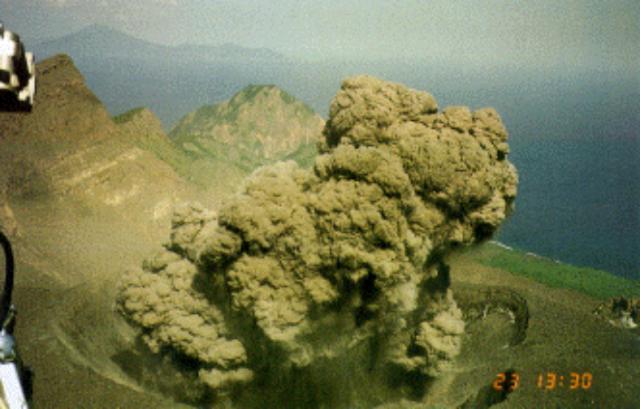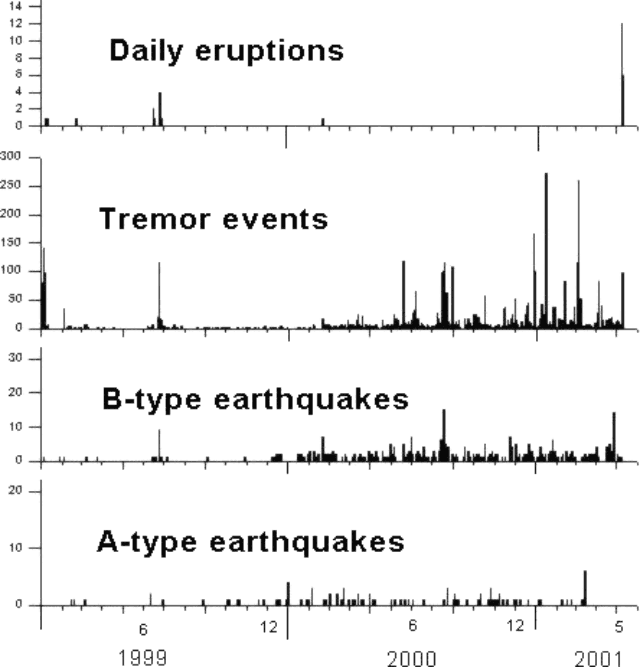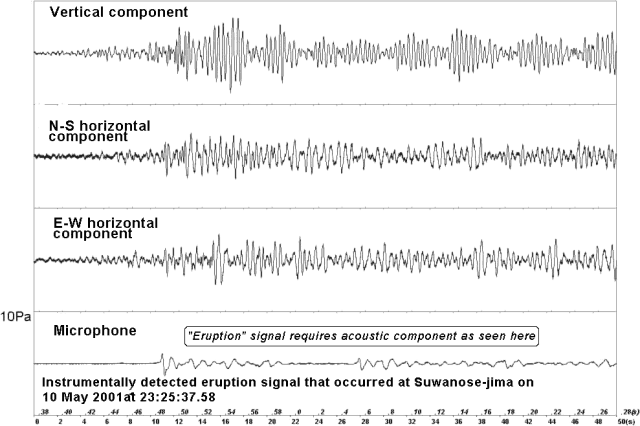Report on Suwanosejima (Japan) — July 2001
Bulletin of the Global Volcanism Network, vol. 26, no. 7 (July 2001)
Managing Editor: Richard Wunderman.
Suwanosejima (Japan) Explosive eruptions in May and July
Please cite this report as:
Global Volcanism Program, 2001. Report on Suwanosejima (Japan) (Wunderman, R., ed.). Bulletin of the Global Volcanism Network, 26:7. Smithsonian Institution. https://doi.org/10.5479/si.GVP.BGVN200107-282030
Suwanosejima
Japan
29.638°N, 129.714°E; summit elev. 796 m
All times are local (unless otherwise noted)
Several eruptions occurred at Suwanose-jima in May-July 2001. Beginning on the morning of 9 May 2001 volcanic activity increased at Suwanose-jima when a tremor event commenced (figure 4). The tremor increased at 1100 and became more violent at 2100.
On 11 May an eruption produced ash clouds that rose to 1.8-7.6 km altitude. A seismo-acoustical record of an eruption signal on 10 May is shown on figure 5. Abundant ash fell on 11 May [in the village ~4 km SSW of the active crater].
Vigorous eruptions on the evening of 12 May and the morning of 13 May deposited up to 3 cm of ash in the village (figure 6). At 0900 on 14 May the eruption seemed to have stopped.
 |
Figure 6. Photo taken from a helicopter of the beginning of the 12 May eruption at Suwanose-jima. Courtesy of the Japanese Meteorological Agency. |
The Sakurajima Volcano Observatory also reported that plumes associated with volcanic tremor events have been observed at Suwanose-jima since the new crater was formed during the December 2000 eruption.
Volcanic tremor was also detected near Suwanose-jima's On-take (Otake) crater beginning at 2200 on 25 July and lasting until at least 26 July. JMA reported that an eruption on 26 July at 1430 produced a volcanic plume that rose to 1.3 km above the crater and drifted to the S. That day seismometers ~2 km SW of the crater recorded explosions at 0501, 0558, 0935, and 1055. Ash fell [in the village] the morning of 26 July.
Geological Summary. The 8-km-long island of Suwanosejima in the northern Ryukyu Islands consists of an andesitic stratovolcano with two active summit craters. The summit is truncated by a large breached crater extending to the sea on the E flank that was formed by edifice collapse. One of Japan's most frequently active volcanoes, it was in a state of intermittent Strombolian activity from Otake, the NE summit crater, between 1949 and 1996, after which periods of inactivity lengthened. The largest recorded eruption took place in 1813-14, when thick scoria deposits covered residential areas, and the SW crater produced two lava flows that reached the western coast. At the end of the eruption the summit of Otake collapsed, forming a large debris avalanche and creating an open collapse scarp extending to the eastern coast. The island remained uninhabited for about 70 years after the 1813-1814 eruption. Lava flows reached the eastern coast of the island in 1884. Only about 50 people live on the island.
Information Contacts: Japanese Meteorological Agency (JMA), 1-3-4 Ote-machi, Chiyoda-ku, Tokyo 100 Japan; Tokyo Volcanic Ash Advisory Center, Tokyo, Japan (URL: http://ds.data.jma.go.jp/svd/vaac/data/); Disaster Prevention Research Institute, Kyoto University, Japan (URL: http://www.dpri.kyoto-u.ac.jp/); Setsuya Nakada and Hidefumi Watanabe, Volcano Research Center, Earthquake Research Institute, University of Tokyo, Yayoi 1-1-1, Bunkyo-ku, Tokyo 113-0032, Japan (URL: http://www.eri.u-tokyo.ac.jp/VRC/index_E.html).



